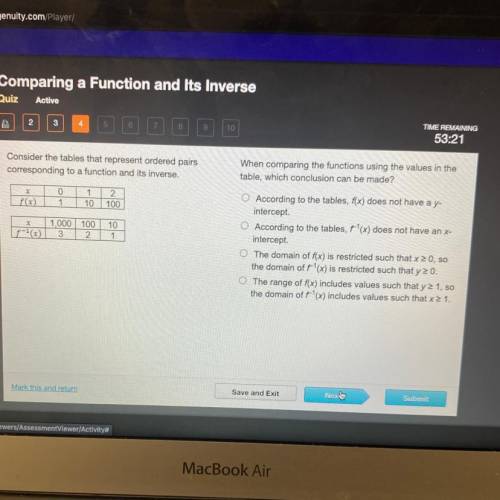Consider the tables that represent ordered pairs
corresponding to a function and its inverse.
...

Mathematics, 11.08.2021 01:50 PastelHibiscus
Consider the tables that represent ordered pairs
corresponding to a function and its inverse.
X
f(x
0
1
1
10
2.
100
X
10
1,000 100
3 2
When comparing the functions using the values in the
table, which conclusion can be made?
According to the tables, f(x) does not have a y-
intercept.
O According to the tables, f'(x) does not have an x-
intercept.
The domain of f(x) is restricted such that x 20, so
the domain of f'(x) is restricted such that y 20.
O The range of f(x) includes values such that y 21, so
the domain of f'(x) includes values such that x 21.
1


Answers: 1


Other questions on the subject: Mathematics


Mathematics, 21.06.2019 18:50, xlebrny1215
Which translation maps the vertex of the graph of the function f(x) = x2 onto the vertex of the function g(x) = x2 – 10x +2?
Answers: 1

Mathematics, 21.06.2019 20:20, oscarmasinde44
Abag contains 3 red marbles, 2 blue marbles, and 2 green marbles. one marble is picked, then another marble. assume that the selections are made with replacement. a) find the probability of picking two red marbles with replacement. b) find the probability of picking a red marble and a blue marble. assume the selections are made without replacement. c) find the probability of picking two red marbles without replacement. d) find the probability of picking a red marble and a blue marble without replacement.
Answers: 1

Mathematics, 21.06.2019 21:30, fara26
*let m∠cob = 50°30’, m∠aob = 70° and m∠aoc = 20°30’. could point c be in the interior of ∠aob? why? a. point c could be the interior of aob but it is not the only case b. point c is the interior of aob c. point c is not the interior of aob d. the given is not possible for the plane geometry answer
Answers: 1
You know the right answer?
Questions in other subjects:

Physics, 06.11.2019 03:31

Social Studies, 06.11.2019 03:31

Mathematics, 06.11.2019 03:31


Mathematics, 06.11.2019 03:31




Mathematics, 06.11.2019 03:31




